Big Sky Country Sapphire: Visiting Montana’s Alluvial Deposits
Sapphire has been mined in the western U.S. state of Montana for more than a century and a half. Historically, gem-quality sapphires have been mined commercially in four main areas in southwestern Montana, shown in figure 1: the upper Missouri River gravel bars (1865), Dry Cottonwood Creek (1889), Rock Creek (1892), and Yogo Gulch (1895). Today, the first two areas remain quite active, while operations in Yogo Gulch and Dry Cottonwood Creek have been suspended for many years. To better understand the characteristics of Montana sapphire and record current mining and commercial activities, GIA sent a team to visit the placer deposits at the upper Missouri River and Rock Creek areas in August 2015.
Since the latter half of the 19th century, Montana’s history has been intertwined with gold, silver, and copper mining. Corundum was discovered during the course of gold mining activities in southwestern Montana. Before the 1940s, the state’s alluvial sapphire deposits were exploited mainly to supply the watch industry, but production fell dramatically with the use of synthetic sapphire in watch bearings (Emmett and Douthit, 1993). Among Montana’s secondary deposits, Rock Creek (figure 2) is the only area mined specifically for sapphire from its discovery in 1892 until World War II (Clabaugh, 1952).
While Yogo Gulch is a primary deposit, the placer deposits at Rock Creek, Dry Cottonwood Creek, and the upper Missouri River near Helena have been a matter of speculation among researchers trying to work out the origin of these sapphire crystals. Research indicates that they were carried to the surface by volcanic activity, but their ultimate origin is still an open question, even after about 125 years of searching (e.g., Pratt, 1906; Clabaugh, 1952; Garland, 2002; Berg and Dahy, 2002; Berg, 2014; Zwaan et al., 2015). Due to the lack of significant sapphire-bearing host rock outcrops in these areas, the search and discussion continue. The glamour of the sapphires, the mysteries of their origin, the area’s mining history, and the natural beauty of Big Sky country are an intriguing combination (figure 3).
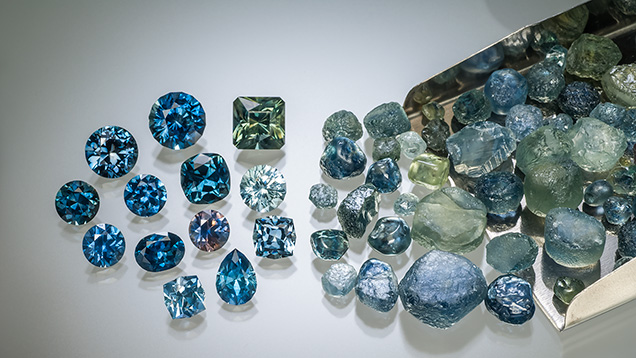
MISSOURI RIVER
Gold miners first discovered Montana sapphire crystals in 1865, in the gravel bars along the upper Missouri River, about 15 miles northeast of Helena. Kunz (1894) reported that the sapphires were found by an “earnest and reliable prospector” named Ed R. Collins in 1865. Collins had some of the Eldorado Bar sapphires cut in New York by Tiffany & Co. and M. Fox & Co., as well as overseas, as part of an effort to locate a potential market. The first scientific reference to these stones was in 1873, when Dr. J. Lawrence Smith described them in the American Journal of Science. Smith had some of the sapphires faceted and stated “my opinion is that this locality is a far more reliable source for this gem variety of corundum than any other in the United States that I have yet examined.” Today, seven different small-scale commercial operations are active in the Missouri River area, some of which mainly cater to tourists. Some of the finer rough is sold to jewelers, gem dealers, and hobbyists who facet these gems. In addition, there are several other areas along the Missouri River where sapphires are mined by hobbyists, including McCune Bar and Gruell’s Bar.
On October 8, 1942, President Roosevelt issued War Production Order L-208, which closed all gold mines in the United States. The order was designed to shift gold miners to commodities that were essential to the war effort, such as copper, and to allow the shipment of mining equipment to U.S. allies, including the Soviet Union (Hammett, 1966).
The Perry-Schroeder Mining Co. was given special permission to continue dredging gold on Eldorado Bar throughout the war, because its significant sapphire by-product had military applications (Ball, 1943). The various non-gem uses included bearings for bombsights and torpedoes, as well as abrasives in grinding wheels. From 1940 to 1944, the Perry-Schroeder gold dredge on Eldorado Bar recovered approximately seven million carats of sapphires of all qualities, most of which were sold for industrial purposes (Clabaugh, 1952).
During this trip, we visited the Eldorado Bar (figure 4) and Spokane Bar deposits, which are active sapphire mining sites. Cass Thompson, owner of the Spokane Bar deposit and one of the six independently owned mines at Eldorado Bar, took the team on a boat tour of Hauser Lake, a reservoir on the Missouri River near Helena. The Missouri River flows from southeast to northwest in this portion of Montana. In addition to other occurrences of known sapphire-bearing gravel, there are at least nine historical sapphire bars (geologically known as strath terraces). These gravel bars, shown in figure 5, have long been known as American Bar, Eldorado Bar, Dana’s Bar, McCune Bar, Metropolitan Bar, Spokane Bar, French Bar, Gruell’s Bar, and Emerald Bar. Many of these deposits were exploited in the late 1800s and early 1900s, and remnants of the old mining activities can still be found. All of the sapphire deposits are distributed along this approximately 14-mile section of the original river. The deposits extend downriver to the northwest from Canyon Ferry Dam to Hauser Dam—essentially all of Hauser Lake—in gravel bars on both sides of the river channel, as well as the riverbed itself. Sapphires are very rarely found northwest of American Bar. When each dam was built, the river level rose dramatically, so the lower layers of many previously exposed gravel bars have been submerged ever since.
Rocks in this area include argillites of the Precambrian Belt series, Paleozoic sedimentary rocks, Tertiary lake sediments and volcanic materials, and Cretaceous or Tertiary intrusives (Clabaugh, 1952). Gravel layers sit directly above the Precambrian Belt series metasedimentary rocks (figure 6). The thickness of the gravel layers varies and at some localities is more than 40 feet. According to Thompson, some gravel bars have a very thick sapphire-bearing layer but are expensive to operate due to extremely thick overburden, as is the case at Dana’s Bar and some portions of Eldorado Bar.
At Eldorado Bar, a mine run was prepared for GIA’s corundum collection. The team witnessed the entire day’s operation as approximately 100 cubic yards of gem-bearing gravel were run through the mechanized processing plant. This process started with gravel extraction in the morning, during which a complete rock profile was exposed (figure 7). Topsoil, overburden sediments, a volcanic ash layer, a gravel layer, and metasedimentary bedrock were observed from top to bottom in the mining pit. The overburden in this particular area is about six feet deep, which makes it relatively easy to remove. Other parts of Eldorado Bar have more than 100 feet of overburden, making these areas uneconomic to mine.
Extracted gravels are then transported by front-end loader to a nearby screen separator to get rid of the larger rocks that might break the onsite washing facilities. Materials are fed on a conveyor belt to a rotating trommel (figure 8). The trommel separates the gravel into different size fractions, diverting material over a certain size to the waste piles. At this point the remaining gravels are more likely to contain sapphires. The heavy minerals in the ore, including sapphires, are further concentrated using water, gravity separation, and a series of screens and jigs, and sluices are used to process the remaining ore.
Many of the sapphires are first removed by hand from the bottom of the mechanized processing plant jigs. All of the concentrate is combed through a second time, either on a light table or by hand jigging in water, and then flipped over onto a table. If this is expertly done, the minerals with the highest specific gravity—sapphires have an SG of 4.00—are concentrated on top in the center of the pile. The authors were informed that currently a small quantity of gold is found with the sapphire. Vast amounts of gold were sometimes recovered in the late 1800s when miners used the highly destructive method of hydraulicking, and in the early 1900s when the Perry-Schroeder dredge was operating (Lyden, 1948). Present-day miners will extract the gold to pay for a portion of the mining costs.
Sapphire crystals from the mines at Eldorado Bar generally have different shades of pastel colors, particularly bluish green and greenish blue. Pink, purple, yellow, deep green, and the rare ruby are found sporadically at this location. Some rather large stones have been recovered. One of the authors (RK) has examined a gem-quality hexagonal tabular crystal weighing nearly 50 ct—it was mounted in a pendant, so the exact weight is unknown.
At the end of our day at Eldorado, a total of 1,045 carats of sapphire were recovered from the mine run, with the largest stone weighing 16.78 ct (figure 9). Also of note was a pink stone weighing 7.86 ct. All of these sapphires are now in the GIA corundum collection in Carlsbad, California.
Today, many of the sapphires mined at the Missouri River deposits are sold—rough and cut—in their natural state. If the transparency is greatly decreased due to dense concentrations of exsolved rutile, they can be heated to change both their transparency and color (figures 10 and 11). Beautiful heat-treated faceted sapphires are produced from Missouri River material.
The origin of sapphires found in the Missouri River gravel bars has been discussed since their discovery in the late 1800s. Pratt (1906) reported a dike containing greenish sapphires about three miles below the Canyon Ferry at French Bar in 1900. A similar rock had been described by Kunz (1890). This rock, called “trachyte rock” by Kunz, came from a dike near the river and above Eldorado Bar. Later, Clabaugh (1952) checked the reported dike location at French Bar and found a similar dike but no sapphires. These reported dikes are still the only source rocks that have ever been proposed. Experts agree that a small outcropping above French Bar containing sapphires in matrix could not have been responsible for the massive quantity of sapphires along the roughly 14-mile stretch of present-day Hauser Lake—there must have been another source or sources. No new origin model has been proposed for the sapphires extracted from the upper Missouri River deposits.
ROCK CREEK
Sapphires were discovered at Rock Creek, popularly known as Gem Mountain, along its tributaries in 1892. The American Gem Mining Syndicate was incorporated in 1901 in the town of Philipsburg, with headquarters in St. Louis, Missouri. The company’s top priority was to mine and market sapphires from several different gulches at the huge Rock Creek deposit. While they also maintained sapphire cutting facilities, the bulk of their Rock Creek rough was shipped to the company’s factory in Geneva, Switzerland. Most of it was consumed by the watch industry for bearings, with smaller amounts used as industrial bearings and as faceted stones set in jewelry. Large-scale mining took place at Rock Creek between 1906 and 1923.
Mining resumed for a brief time before World War II, until synthetic sapphire took over the watch component market. Since then, Rock Creek sapphires have been extracted solely for jewelry making and mining tourism, with most of the stones undergoing heat treatment. Large-scale mechanized mining and processing facilities have recently been installed, marking the start of a new era of Montana sapphire mining.
Historically, sapphires were mined from Anaconda Gulch and Sapphire Gulch, although many other gulches were also worked (figure 12). Similar to the upper Missouri River area, bedrock in this district is argillite of the Mesoproterozoic Belt Supergroup, overlain by Eocene volcanic rocks from different eruptive events (Berg, 2014). According to Clabaugh (1952), intrusions of either Cretaceous or Tertiary age also occur in this area. The sapphires are found in loose sediments. Currently, two operations are active at Rock Creek: Potentate Mining and Gem Mountain Sapphire Mine. For this trip, the GIA team visited Potentate’s mining and washing operations and Gem Mountain's sapphire tourism and heat treatment facilities.
At Eureka Gulch, Dr. Keith Barron, geologist and owner of Potentate Mining, described the nature of the sapphire-bearing deposits. Unlike the river gravel layers at the upper Missouri River area, these sapphire-bearing sediments lack the well-defined layering pattern formed by river flows. Instead, gravels and boulders of different sizes are randomly mixed (figure 13). Barron concluded that sapphires are buried in mudflows instead of riverbeds in the Gem Mountain area (Barron and Boyd, 2015). Since mudflow is a rapid mass-wasting process, emplacement can cover both topographic lows and highs. After mudflow emplacement, the local topography is often shaped again by weathering and erosion to form gullies and ridges. Today, sapphire-bearing mudflow deposits are found both in gulches and hilltops in Potentate’s mining sites. For instance, Potentate set up their dry screening/concentrating operation on a hilltop (bench), and the bulk sampling pit has turned out to be quite productive (figure 14).
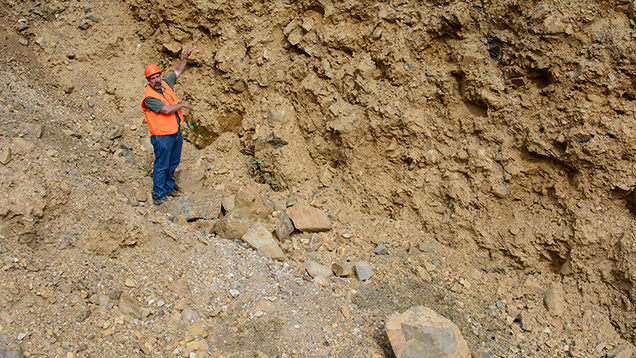
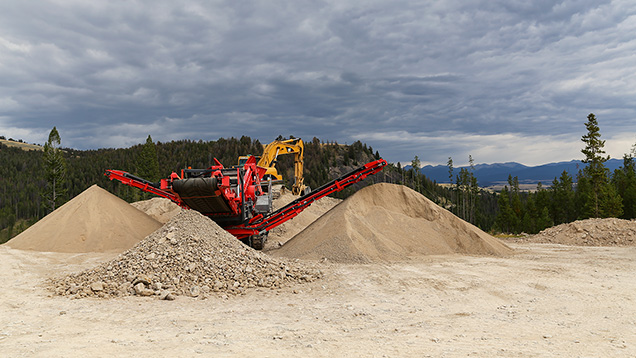
Although sapphires have not yet been observed in situ in this area, aeromagnetic surveys of the Potentate property also reveal potentially sapphire-bearing igneous bodies beneath the surface. Potentate is mainly working on the Eureka Gulch deposit and bulk sampling the Sapphire Gulch deposit. The former is primarily for gold mining, with sapphire as a by-product, while the latter is focused on sapphire.
Sapphire Gulch material with a size range of 1/8 inch to 1 inch also goes through the washing plant at Eureka Gulch (figure 15). Sapphire concentrates extracted from the jigs are then sorted by hand. The washing plant’s capacity is about 50–60 cubic yards (38–46 cubic meters) per hour. After observing the washing process, our team hand-picked sapphire from the jig. About 13–15% of the production had attractive natural colors of blue, greenish blue, yellow, or pink. Most of the remaining sapphires have green and brownish colors that react very well to heat treatment.
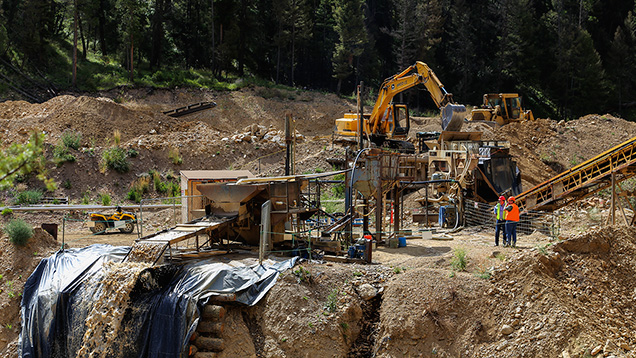
Potentate’s first mining season at Rock Creek was in 2015, and was very successful. The 2016 mining season near Sapphire Gulch recovered about 220 kilograms of rough sapphire larger than 3.5 mm. According to Potentate marketing director Warren Boyd, the mining operation recovered about 150 kilograms of rough sapphire under 3.5 mm, suitable for very small faceted gemstones and beads. Boyd added that Potentate’s objective is to become a major international rough sapphire supplier in the next few years.
Gemstone cutters are important buyers of the rough sapphires mined by Potentate, with stones ranging from 2.5 to 6.0 mm best suited for precision cutting. In today’s market, these sapphires will command a premium price if they are custom-faceted or sold in their natural, unheated state. Jeffrey Hapeman of Earth’s Treasury (Westtown, Pennsylvania) has faceted many Rock Creek sapphires, applying special cut styles such as “Helena Oval,” named after Montana’s capital (figure 16). Rachel Abel of Americut Gems is working on heat treating and precision cutting sapphires purchased from Potentate. She uses robotic cutting systems to precisely facet stones ranging from 2.5 to 4.5 mm. The stones are faceted as modified round brilliants and to display the “hearts and arrows” effect seen in some diamonds.
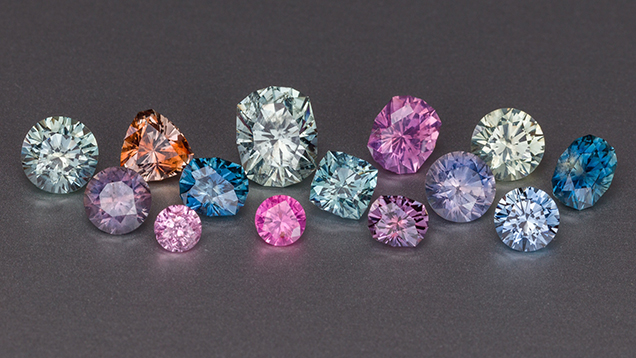
Gem Mountain Sapphire Mine is a diversified business, with a mining site at Rock Creek, a heat treatment facility, a gravel washing site for tourists, and a jewelry store in Philipsburg. The mining at this site is quite different from Potentate’s large-scale mechanized operation in the same area. Sapphire-bearing gravels are extracted and transported to the tourist washing site and to the jewelry store for sale.
As the authors witnessed, untreated rough sapphires from Rock Creek generally have more saturated colors than those from the upper Missouri River, but pastel colors are still the most prevalent. Many of the heated stones have color zoning and a brightly colored center that corresponds to lighter or nearly colorless zones in the untreated crystals (figure 17). Local miners call this bright center “yolk.” Kunz (1901) noted that Rock Creek sapphires are notable for small colored spots, which when properly cut and positioned can color the entire stone when looking down the table. He also observed that many fancy colors from this area are quite distinct compared to other sources, and that the pink stones in particular can be intensely brilliant. These descriptions matched our own observations (again, see figure 16). Many Rock Creek sapphire crystals show a clear hexagonal habit, similar to those from the Missouri River gravel bars.
The origin of Rock Creek sapphires has drawn the attention of researchers, yet as of this writing, no in situ sapphires have been found. In the most recent study on Rock Creek sapphires (Zwaan et al., 2015), the inclusion studies and chemical composition analysis pointed to a plumasitic/metasomatic origin. Palke et al. (2015) performed a study on the glassy melt inclusions in sapphires from both Rock Creek and the Missouri River. The study showed abnormal two-phase inclusions consisting of a glassy solid and a gas. Chemical study indicates that the glassy solid phase is of dacitic to trachydacitic composition. This ongoing study could provide more information on the crystallization of these alluvial sapphires. Previous research by Berg and Cooney (2006) on stones from the same area revealed two characteristic materials attached to the surface: felsite and kaolinite. The study speculated that surface features such as grooves and flats underneath the adhering felsite were from resorption (solution) of the sapphires when they were transported in the felsic magma. Attached kaolinite formed from alteration of feldspars in the volcanic ash also indicates that the sapphires were derived from felsic volcanic rocks.
HEAT TREATMENT OF ROCK CREEK SAPPHIRES
While gemstones have been heated to enhance their quality for thousands of years, a well-controlled high-temperature heating environment has only existed for the past 30–40 years. The authors were offered the opportunity to record the entire process of heat treatment of Rock Creek sapphires at the Gem Mountain facility nearby.
Rock Creek has had considerably higher sapphire production than the other alluvial deposits in Montana over the years, and many people consider it the only alluvial deposit that can be economically mined on a large scale for sapphire alone. Emmett and Douthit (1993) reported that about 8% of Rock Creek sapphires can be marketed as gems, while 65–70% of the production is of pale greenish and bluish colors that are acceptable to the jewelry market (figure 18). Since color is the most important value factor for sapphires, enhancing the stones’ color became a priority.
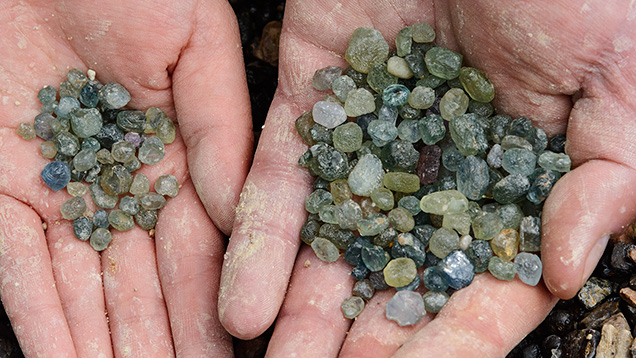
The electrical furnace (figure 19) and the method used are the same as those published in Emmett and Douthit (1993). Today, rough sapphires submitted to Gem Mountain for heat treatment are carefully documented and go through two rounds of heating (figure 20). The first round, called the “fancy burn,” is done under an oxidizing environment. After the fancy burn, the stones’ color is evaluated; the ones that did not gain satisfactory fancy colors such as yellow, orange, and pink will go to the second round of heating. The second round is the “blue burn,” done under a reducing environment. When both rounds of treatment are complete, the stones are reevaluated. Cutting and manufacturing decisions can then be made.

According to Chris Cooney, owner of Gem Mountain Sapphire Mine, about 30–40% of the stones gain a marketable bluish color after the “blue burn” (figure 21). While heating itself risks damage to the stone, the most tedious but most critical step in heat treatment at Gem Mountain is the evaluation of the stones after each round (C. Cooney, pers. comm., 2015). Color zoning and color concentration at the center of many stones further complicate the evaluation process. Rough that was treated in an oxidizing environment (producing darker yellow, orange, and pink colors) will often have a dark central color concentration, while many of the stones heated in a reducing environment will have a colorless or very light yellow spot in the center. The concentrated color spots can brighten the entire stone, but sometimes they combine with the bodycolor of the stone, producing unpleasant results. Since many stones are also cut by contractors of Gem Mountain, this evaluation also plays an important role in the process.

Cooney compares the heat treatment of sapphire to cooking, in that procedures are adjusted based on intuition and years of experience. Not all Montana sapphire yields predictable or desirable results from heat treatment; the nature and chemical composition of the stone are critical, as are temperature-time profiles and the conditions inside the furnace (Kane, 2008).
The heating service is not just for the tourists who extract their stones at Gem Mountain. Sapphires sourced elsewhere are also submitted for treatment. Over the years, Cooney has found that sapphires from certain sources achieve better results, while others hardly change color.
MONTANA SAPPHIRE TOURISM
Gem tourism is an essential component, in some cases the only one, of sapphire-related businesses in Montana (figure 22). The authors observed the tourist activities at both Gem Mountain and one of the upper Missouri River operations.

The tourist bucket mining facility at Gem Mountain is about 16 miles southwest of Philipsburg. Gravels removed from the neighboring mining claim by mechanized mining methods are transported to this site, where domestic and international tourists can purchase sapphire-containing “gravel bags” of various sizes. They can either wash their gravels onsite (again, see figure 22) or take them home. Most of the sapphire mines, including Gem Mountain, will mail gravel bags to people who cannot visit in person. Sapphires found can also be evaluated by staff with years of experience. Visitors can choose to keep the stones as they are or have them heat-treated, faceted, or even mounted in jewelry by Gem Mountain’s staff. They are encouraged to have larger stones cut and mounted locally to help the local economy. The heat treatment and cutting and manufacturing services set this business apart. Tourists have fun treasure hunting, but also see the whole mine-to-market story happening for themselves.
The authors asked several visitors at the washing site about their experiences at Gem Mountain. We were surprised to see them wearing jewelry mounted with sapphires found there over the years (figure 23). Through our conversations, we learned that many of the tourists have returned repeatedly over the last 10–15 years. They come with family and friends in what has become an annual ritual for some. It is not uncommon to see a couple showing off an engagement ring with their own handpicked sapphire on social media.
At the upper Missouri River operations run by Spokane Bar Sapphire Mine, tourists can purchase gravel bags at the store and wash them on- or off-site. Besides gravel washing, mine owner Cass Thompson and other Montana sapphire miner operators also offer a special mine run service (figure 24). With advance reservations, clients—who range from gemstone wholesalers, to interested clients from outside the gem and jewelry industry—can purchase a certain number of dump truck loads (measured in cubic yards). These will be run through the commercial mechanized mining plant—which can take as long as eight hours for an 80-yard run—which concentrates the gem-bearing gravels along with non-sapphire accessory minerals such as hematite and garnet. These customers come to see the mining process, and at the end of the day they pick up their concentrates from the jig and take them home to sort for fun.
SUMMARY
As one of the “Big Three” colored gemstones, sapphire has always been a focus of exploration and gemological education. The related history, geology, and business models are all of interest to those who trade in sapphire. Montana is one of the few major gemstone sources in the United States. Over the past 150 years, countless people have devoted themselves to prospecting and mining these sapphire sources. The success of these operations has often been difficult to achieve, but the passion for these sapphires has persisted.
Today, the alluvial sapphire deposits are still actively mined. Although small-scale mining still prevails in these areas, Potentate Mining’s large mechanized operations with heavy investment could change the dynamic of sapphire mining in the Rock Creek area (figure 25). Meanwhile, sapphire tourism is quite important to the local economy.
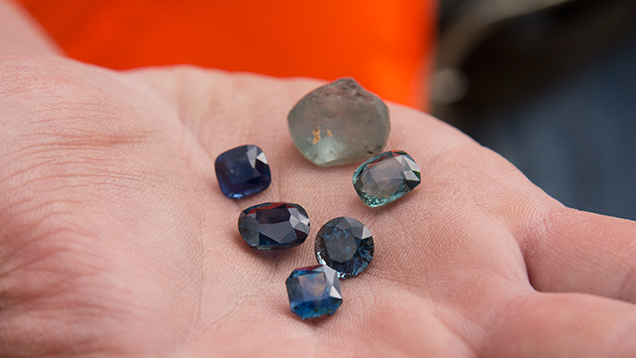
One thing the different operators have in common is their commitment to protecting the environment. The sapphire mining happens in harmony right next to agriculture land, and we were encouraged to see them taking responsibility for restoring the land. The miners follow state guidelines regarding water and land reclamation. For example, the Eldorado Bar and Potentate Mining pits are refilled after mining. Potentate also plants trees after operations have ceased; water from their washing plants is filtered and restored to potable levels.
As stakeholders in the local economy, the mines maintain good relationships with neighboring farms and businesses. Many miners are from the area and have worked on the sapphire fields for years, so they have an emotional connection to the land and the stones being extracted. Montana sapphire is a gemstone that Americans are proud of. As Cass Thompson put it, “They love the idea of keeping the state of Montana just as beautiful as the sapphires they pull out.”



